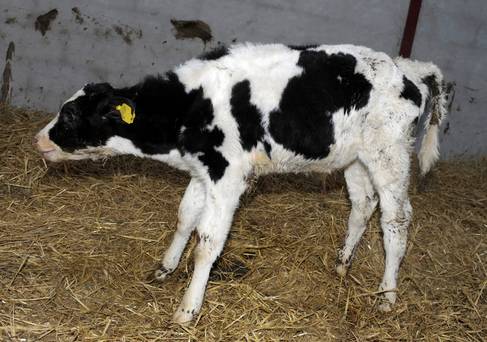

The sight of bloody calf scours is a disturbing one, but the condition is not always fatal. Pinpointing the cause of scours through diagnostics is the best approach to effective treatment, and prevention of future cases.
The source of scours tends to follow a continuum consistent with age of the calf. Scours in the first few days of life is very challenging to diagnose. But after that, it becomes easier to nail down the cause based on how old the animal is.
Not all scours are caused by bacteria. Viruses and parasites also play a role, and inconsistent feeding or rapid dietary changes can upset the gut flora and cause nutritional scours. If you see bloody scours, they typically are the result of one of three organisms – Salmonella, coronavirus or coccidia. These three causes may overlap a bit in age, but knowing about the presence of blood, the calf’s age, and other factors such as seasonality, helps us zero in on the necessary diagnostic tests quickly.
Salmonella – The earliest cases of bloody scours likely will be caused by a strain of salmonella, and typically will surface when calves are 4 to 10 days old. Salmonella is a bacteria that likes the warm and humid temperatures, but is very adaptive to survive in odd environments like the dry and dusty corners of a calf barn. There are many serotypes of salmonella that are pathogenic to calves, some of which also can be highly infective in humans. Salmonella Newport is one such zoonotic bacteria that frequent infects human caretakers. Salmonella Dublin, although uncommon, can cause serious illness in humans. Salmonella Heidelberg has emerged recently as a highly potent calf-killer, causing death losses in 25 to 60% of affected calves in as swiftly as 4 to 8 hours. S. Heidelberg is resistant to many antibiotics, and has now been diagnosed in people and cattle.
Coronavirus – Coronavirus and its usual companion, rotavirus, surface in calves from about 5 to 30 days of age. While the two often occur in tandem, coronavirus is the one that causes bloody scours, and also may cause respiratory symptoms. About 70% of adult cows shed coronavirus in their feces, and it has a long survival life on-farm, surviving in manure for up to 9 months. Often called “winter dysentery,” coronavirus loves cold weather, and also can be spread from calf-to-calf.
Coccidiosis – Infection by the coccidia parasite can occur from 1-2 weeks to several months of age. The parasite has a 3-week incubation period from the time of infection to the shedding infectious parasites into the environment. Most of these infections (95%) are subclinical, but other stressors on the animal, and/or an overwhelming dose of coccidia will cause visible symptoms, including the presence of blood in the stool. Coccidiosis occurs more frequently in warm, moist climates; a hard frost is helpful in breaking its reproduction cycle in the environment.
Interestingly, the three causes of bloody scours are three different types of organisms – a bacteria, a virus and a parasite. Antibiotics only are effective on bacteria. And even if the cause is a bacterial, not every bug will succumb to every drug. For example, coronavirus often is confused with Salmonella because they present similar symptoms in a parallel timeframe. But effectively treating and preventing the two diseases requires different approaches.
In all cases of calf scours, supportive therapy such as extra fluids and pain management often will best serve the calf. If the cause is bacterial, antibiotic sensitivity testing may be necessary to select the most effective treatment and bring an outbreak under control.
 Contact Jaguza Support
Contact Jaguza Support